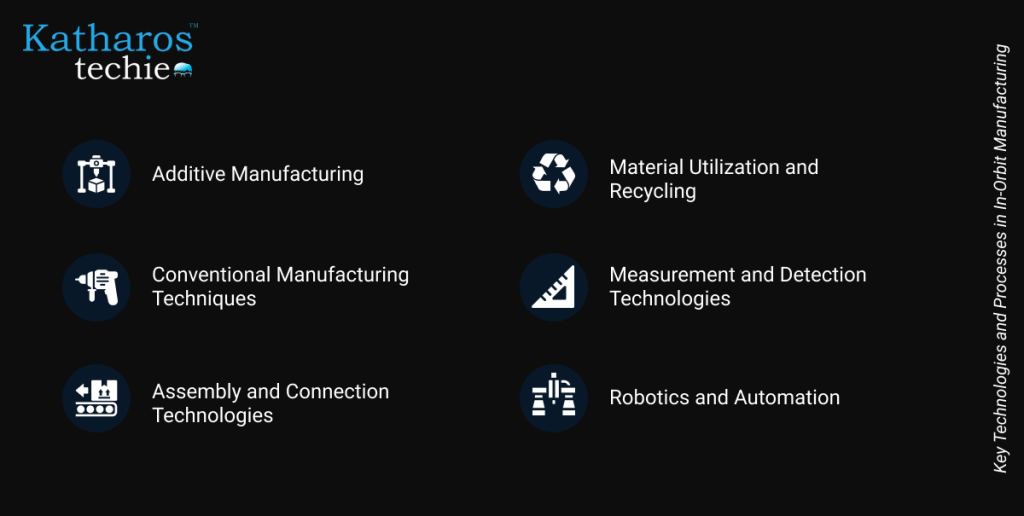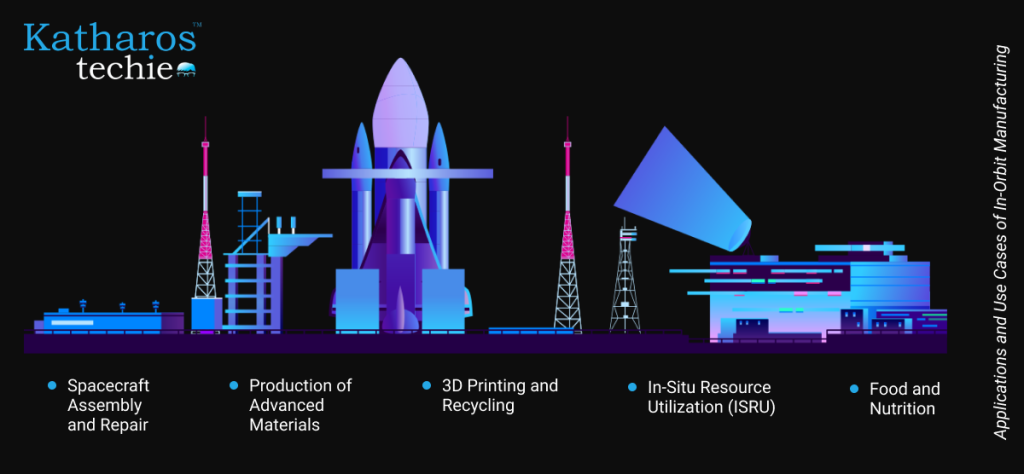
In-Orbit Manufacturing: The Future of Space-Based Production
By Ankita Das

In-orbit manufacturing, also known as in-space manufacturing (ISM), represents a revolutionary shift in how goods are produced and assembled beyond Earth’s atmosphere. This technology involves the fabrication, assembly, or integration of tangible goods in space. Thus, leveraging unique conditions such as microgravity and vacuum to create or improve space-based production. The advantages of in-orbit manufacturing are multifaceted, including the ability to bypass launch constraints, reduce costs, and enhance mission flexibility. It enables the production of advanced crystals and pharmaceuticals, which are difficult to manufacture on Earth. It supports long-duration space missions by allowing on-site repair and the creation of essential components. In this blog, we will delve into the world of in-orbit manufacturing, exploring its key features and applications. Scroll down to learn how this technology is transforming space exploration and production.
In-orbit Manufacturing: Importance and Potential Impact
In-orbit manufacturing refers to producing components or assembling structures directly in space, rather than on Earth. It leverages microgravity and vacuum conditions to produce materials with unique properties, such as advanced fibers and pharmaceuticals. The manufacturing process involves 3D printing and robotic assembly for large-scale space constructions that cannot be launched from Earth. This technology improves space missions by enabling on-demand production of spare parts and tools, minimizing dependence on Earth-based supplies.
The importance of in-orbit manufacturing lies in its ability to support long-term space missions. It works by overcoming launch constraints and increasing flexibility and resilience. Economically, it offers cost savings by reducing launch costs and creates new markets for products with properties produced in microgravity. Technologically, it drives advancements in robotics and automation, while strategically, it supports global leadership through new manufacturing technologies.
In the long term, in-orbit manufacturing is crucial for sustainable space exploration. It enables on-demand production, reducing reliance on Earth-based supplies, essential for missions to the Moon and Mars. By enabling in-situ resource utilization (ISRU), this technology facilitates sustainable exploration and development beyond Earth. Overall, in-orbit manufacturing will revolutionize mission capabilities, foster economic growth, and drive technological innovation beyond the earth’s surface.
Key Technologies and Processes in In-Orbit Manufacturing

In-orbit manufacturing relies on several key technologies and processes to produce and assemble components in space. These include:
1. Additive Manufacturing
Additive Manufacturing, also known as 3D printing, plays a crucial role in in-orbit manufacturing. It allows the production of complex parts and tools in space using various materials, enhancing versatility in-space manufacturing. The Made In-Space initiative successfully demonstrated 3D printing at the International Space Station, showcasing its potential for on-demand production.
2. Conventional Manufacturing
Manufacturers adapt conventional techniques, such as casting and machining, for in-orbit use. These methods rely on specialized equipment to control heating and cooling processes in microgravity environments. Techniques like electron beam welding have been successfully demonstrated in space, offering reliable methods for joining materials.
3. Assembly and Connection Technologies
Assembly and connection technologies are vital for constructing large structures in space. These technologies involve robotic systems that can assemble and integrate components with precision, overcoming the challenges of microgravity. On-orbit assembly enables the creation of structures that cannot be launched fully assembled due to size constraints.
4. In-situ Material Utilization and Recycling
Material utilization and recycling are essential for sustainable in-orbit manufacturing. In-situ resource utilization (ISRU) involves using materials found in space, such as lunar regolith, to produce fuel or construction materials. Recycling technologies allow for the reuse of materials, minimizing waste and extending mission durations.
5. Measurement and Detection Technologies
Accurate measurement and detection technologies are critical for successful in-orbit manufacturing. These systems enable precise monitoring of object sizes, motion attitudes, and other parameters necessary for assembly and maintenance tasks. Advanced sensors and imaging systems help navigate complex space environments.
6. Robotics and Automation
Automation plays a central role in in-orbit manufacturing by enabling efficient assembly, maintenance, and repair operations. Autonomous robotic systems can perform tasks with high precision, reducing human intervention and enhancing safety. Dexterous robotic arms are used for delicate assembly and servicing tasks, supporting the construction and maintenance of complex spacecraft components.
In-orbit manufacturing leverages advanced techniques like additive manufacturing, conventional processes, and robotics to revolutionize space-based production. Space manufacturing bypasses launch constraints and boosts mission resilience. Moving forward, let’s explore the diverse applications of in-orbit manufacturing.
Applications and Use Cases of In-Orbit Manufacturing

In-orbit manufacturing offers applications that transform space exploration and development. It enables the creation of complex systems and promotes recycling capabilities. Here are some key applications:
1. Spacecraft Assembly and Repair
Spacecraft assembly and repair are critical applications of in-orbit manufacturing. This technology allows large structures that cannot be launched from Earth due to size constraints. Robotic systems assemble and repair spacecraft components, extending their lifespan and enhancing mission resilience. For example, the Phoenix program involves modular miniature satellites (satlets) that can self-assemble in orbit to generate different spacecraft configurations.
2. Production of Advanced Materials
In-orbit manufacturing enables the production of advanced materials that benefit from microgravity conditions. For instance, high-quality fiber optics and pharmaceuticals are produced in space due to the unique properties achieved in microgravity. These materials have superior performance compared to their Earth-made counterparts. The microgravity environment affects material properties, such as interlayer bonding and structural strength, making it ideal for producing materials with enhanced characteristics1.
3. 3D Printing and Recycling
3D printing in space allows on-demand production of tools and spare parts, reducing reliance on Earth-based supply chains. Recycling technologies complement this by reusing materials, minimizing waste, and extending mission durations. This combination supports sustainable long-term space missions. Zero-G 3D printers and recyclers are being developed for electronics manufacturing, improving the efficiency of space operations.
4. In-Situ Resource Utilization (ISRU)
ISRU involves using resources found in space, such as lunar regolith, to produce fuel, oxygen, or construction materials. This approach is essential for sustainable exploration, as it reduces the need to transport materials from Earth and supports long-term missions on the Moon and Mars. ISRU technologies are critical for establishing self-sustaining bases in space.
5. Food and Nutrition
In-orbit manufacturing also includes the production of food and nutritional supplements. Hydroponic systems and algae-based food production are being explored to provide sustainable nutrition for long-duration space missions. This capability is vital for supporting astronauts’ health during extended stays in space. By leveraging in-orbit manufacturing, future missions can ensure a reliable food supply without relying on resupply from Earth.
The applications of in-orbit manufacturing are diverse and transformative. This technology paves the way for greater space exploration by leveraging varying orbital conditions.
In-orbit manufacturing represents a pivotal shift in space exploration, offering unprecedented capabilities for sustainable missions and technological innovation. Utilizing unique space conditions enables the production of advanced materials and structures, supporting long-term space presence. As this technology continues to evolve, it will play a crucial role in shaping the future of space development. As a result, it will drive humanity toward a more sustainable and interconnected cosmos.